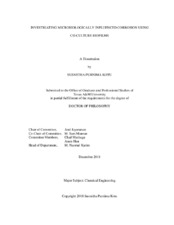| dc.description.abstract | A holistic understanding of microbiologically influenced corrosion (MIC) requires investigation of the underlying microbiological, metallurgical and electrochemical mechanisms. MIC studies are typically conducted using batch reactors or large scale flow loops that are nutrient-limited and have buildup of waste products. To overcome these disadvantages, we developed a continuous-flow, microfluidic microbiologically influenced corrosion model, M-MIC-1, comprising of carbon steel coated glass slide bonded to a microchannel imprinted in a polymer. Using M-MIC1, we investigated the effect of two biocides on short-term and long-term, single-species and co-culture biofilms of Shewanella oneidensis and Vibrio natriegens. We found that biocide resistance was impacted by biofilm type, biofilm growth time and the type of biocide. These results show the importance of conducting biocide screening studies with process fluids for effective MIC mitigation. Our studies illustrate that M-MIC1 flow model provides an ideal platform.
To effectively comprehend MIC mechanisms, we developed M-MIC2 flow model that is amenable to dynamic and integrated measurements of biofilm dynamics and electrochemical impedance. M-MIC2 comprises of a two-metal electrode system with carbon steel and titanium bonded to a microchannel. Preliminary static and continuous-flow studies with single-species and co-culture biofilms of S. oneidensis and V. natriegens in M-MIC2 indicated some correlation of the variations in biofilm biomass to impedance spectra for S. oneidensis biofilms.
We also hypothesized that a systems-level understanding of the microbial community and their metabolism can enhance the understanding of underlying mechanisms. Produced water from a MIC-impacted oil field was exposed to carbon steel coupons to mimic the corrosion environment in the laboratory. We observed an increased abundance (using 16S rRNA sequencing) of the genera, Nitratireductor and Desulfovibrio and unclassified genera of Rhodobacteraceae, Deltaproteobacteria, and Desulfobacteraceace. Based on the metagenome, we predicted an increased abundance of several genes related to energy, carbohydrate, lipid, and xenobiotic metabolism. This correlated to the increased abundance of measured metabolites (using untargeted metabolomics analysis) such as carboxylic acids, fatty acids, and amino acids that were earlier associated with MIC. These analyses can be repeated for multiple MIC-impacted field locations to delineate common features and identify metabolite biomarkers for MIC detection. | en |


